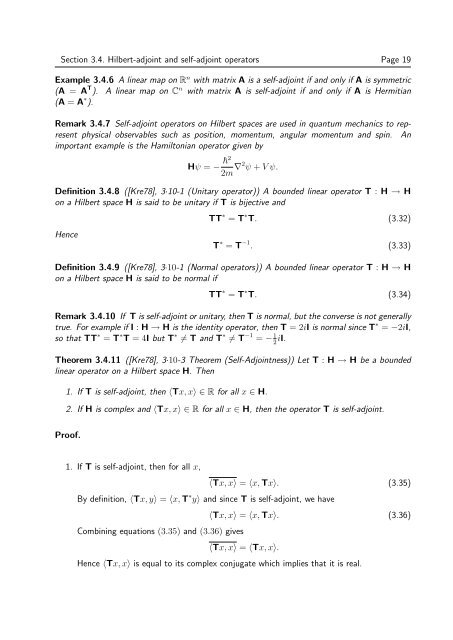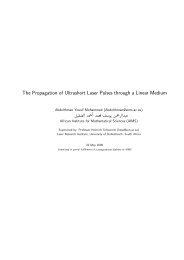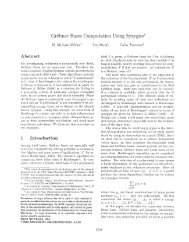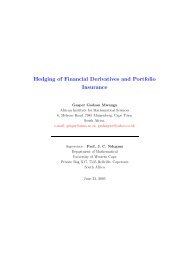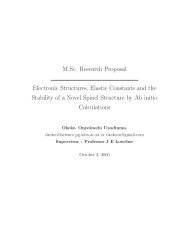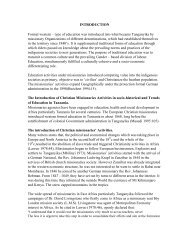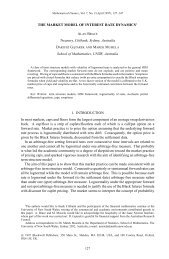Operators on Hilbert Spaces - user web page - AIMS
Operators on Hilbert Spaces - user web page - AIMS
Operators on Hilbert Spaces - user web page - AIMS
Create successful ePaper yourself
Turn your PDF publications into a flip-book with our unique Google optimized e-Paper software.
Secti<strong>on</strong> 3.4. <strong>Hilbert</strong>-adjoint and self-adjoint operators Page 19<br />
Example 3.4.6 A linear map <strong>on</strong> R n with matrix A is a self-adjoint if and <strong>on</strong>ly if A is symmetric<br />
(A = A T ). A linear map <strong>on</strong> C n with matrix A is self-adjoint if and <strong>on</strong>ly if A is Hermitian<br />
(A = A ∗ ).<br />
Remark 3.4.7 Self-adjoint operators <strong>on</strong> <strong>Hilbert</strong> spaces are used in quantum mechanics to represent<br />
physical observables such as positi<strong>on</strong>, momentum, angular momentum and spin. An<br />
important example is the Hamilt<strong>on</strong>ian operator given by<br />
Hψ = − 2<br />
2m ∇2 ψ + V ψ.<br />
Definiti<strong>on</strong> 3.4.8 ([Kre78], 3·10-1 (Unitary operator)) A bounded linear operator T : H → H<br />
<strong>on</strong> a <strong>Hilbert</strong> space H is said to be unitary if T is bijective and<br />
Hence<br />
TT ∗ = T ∗ T. (3.32)<br />
T ∗ = T −1 . (3.33)<br />
Definiti<strong>on</strong> 3.4.9 ([Kre78], 3·10-1 (Normal operators)) A bounded linear operator T : H → H<br />
<strong>on</strong> a <strong>Hilbert</strong> space H is said to be normal if<br />
TT ∗ = T ∗ T. (3.34)<br />
Remark 3.4.10 If T is self-adjoint or unitary, then T is normal, but the c<strong>on</strong>verse is not generally<br />
true. For example if I : H → H is the identity operator, then T = 2iI is normal since T ∗ = −2iI,<br />
so that TT ∗ = T ∗ T = 4I but T ∗ = T and T ∗ = T −1 = − 1<br />
2 iI.<br />
Theorem 3.4.11 ([Kre78], 3·10-3 Theorem (Self-Adjointness)) Let T : H → H be a bounded<br />
linear operator <strong>on</strong> a <strong>Hilbert</strong> space H. Then<br />
1. If T is self-adjoint, then 〈Tx, x〉 ∈ R for all x ∈ H.<br />
2. If H is complex and 〈Tx, x〉 ∈ R for all x ∈ H, then the operator T is self-adjoint.<br />
Proof.<br />
1. If T is self-adjoint, then for all x,<br />
〈Tx, x〉 = 〈x, Tx〉. (3.35)<br />
By definiti<strong>on</strong>, 〈Tx, y〉 = 〈x, T ∗ y〉 and since T is self-adjoint, we have<br />
Combining equati<strong>on</strong>s (3.35) and (3.36) gives<br />
〈Tx, x〉 = 〈x, Tx〉. (3.36)<br />
〈Tx, x〉 = 〈Tx, x〉.<br />
Hence 〈Tx, x〉 is equal to its complex c<strong>on</strong>jugate which implies that it is real.


